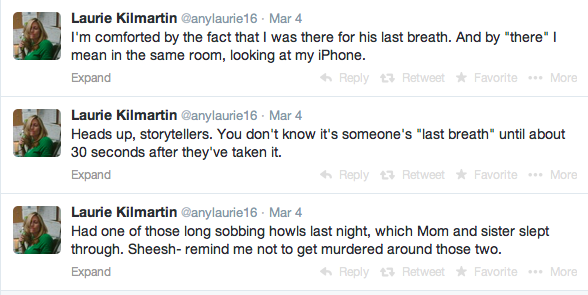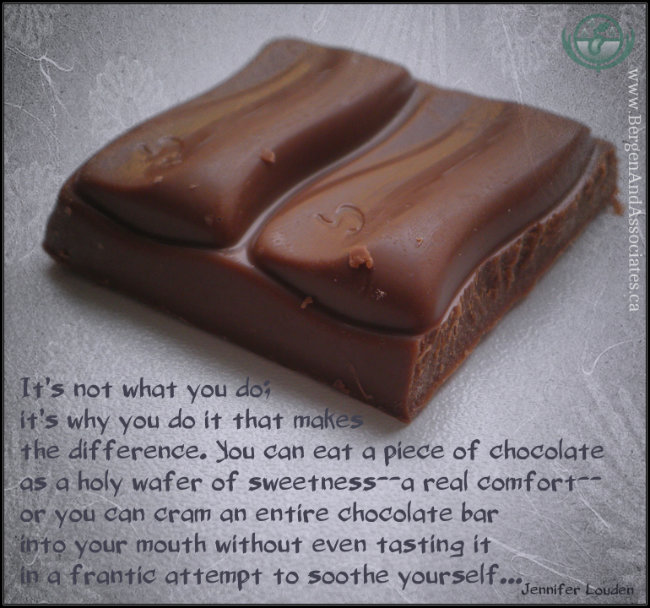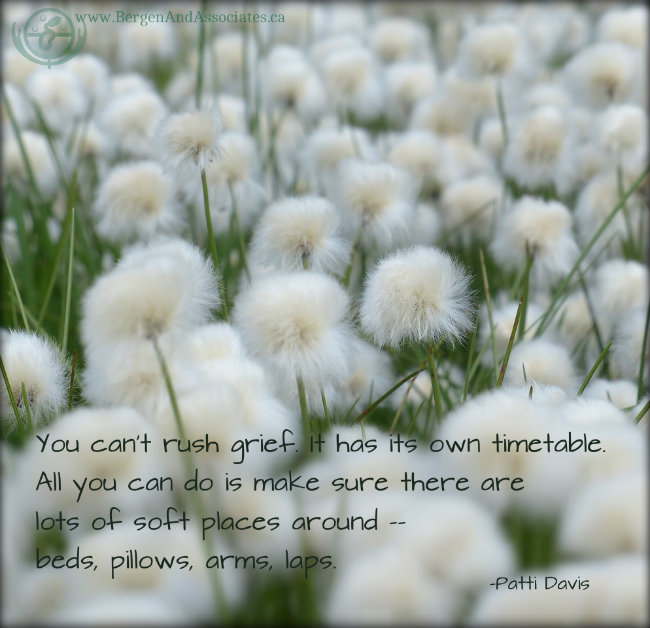I spent some time on Laurie Kilmartin’s twitter account today (twitter handle: anylaurie16), which became very popular as she live tweeted her experience of her father’s last days in early March this year. Now…to be clear, she’s a professional joke writer (for Conan) and a comedienne in her own right, and so her tweets about watching her dad die were both hilarious and profound at a level that few of us are capable…they’re incredible–if you’ve the stomach for black humour.
She had my face confused between simultaneous laughter and tears…she’s bright and witty and terribly funny…quite irreverently so. Her subject material, her father’s death from cancer…had the tweets be both bittersweet and achingly, hauntingly sad. As a writer, she had an incredible way with 140 characters…

Death is raw and real and agonizing…and somehow she manages to pull off expressing it as raw and real and agonizing…and given that she is a comic that seems to live life on the edge…why would she do anything different when she is mourning her father?

I do find it interesting that she recognizes in her last tweet (which is at the top of the pic, given that tweets add new ones above older ones) that she was preoccupied with her iPhone during the moment of his actual death…which may have been a joke, given her license with the truth to be funny…or maybe not.
What I wonder is…did Laurie Kilmartin use live-tweeting her father’s death as a way to preoccupy herself to avoid facing her father’s death…or did she use Twitter to help herself authentically deal with the reality? How would we expect a joke writer to deal with most things authentically?
Did she numb herself with social media, creating conversations with thousands of nameless and faceless folks to help herself leave the pain of the room as she sat in the death vigil? Or did she use Twitter to connect with her community of fellow comics at time when she needed her community around her?
I haven’t got a foggy clue.
There is no way of knowing what this was about for Laurie Kilmartin…and frankly, it’s none of my business what was behind the tweets. In this world of social media…I don’t want to know. I haven’t earned the right to know her heart. But the musing does cue me to a larger question…does using social media like Twitter and Facebook assist in grieving and mourning, or does it get in the way?
Comfort vs. Numbing
I made this poster a few weeks ago:

I like how this quote encapsulates the difference between comfort and numbing.
Comfort mindfully treasures the present and all that it holds…the sensations, the feelings, the spirit of the moment.
Numbing works to shut off the sensations, cut off from feeling the feelings by burying them under an avalanche of something.
Comfort connects us to our own kindness and self-compassion.
Numbing isn’t about kindness or self compassion…it’s about working to feel nothing
Comfort is part of connecting ourselves meaningfully, gently, and thoughtfully to the world…with a hug, a glass of wine with a friend, or an episode of a television show that may get discussed tomorrow at coffee break.
Numbing is about disconnecting from others and oneself…it’s about drinking to take the edge is off, or even off the edge completely. It’s about watching an entire season of a series on Netflix in your pyjamas in the dark, not answering the phone when it rings.
Social media can connect us with those that are loving and caring for us. It can make connections that might otherwise be impossible because of scale or access.
Social media can be used to leave the room even while one’s body is sitting bedside. It can be a way to escape or deny painful realities of the moment by slipping into a world where pain isn’t
I’ve seen social media used powerfully in recent weeks as connecting, comforting ways of grieving:
- Friends of mine had parents who were in a house fire this winter. Their mom died in the fire, and their dad was seriously injured. This man had a large number of children…and their children had large numbers of friends. There was a large extended family and church families and so on and so on. Large numbers of people were connected to Mr. K and his deceased wife directly or indirectly. He was in isolation in the Intensive Care Unit, with only a few visitors allowed. The risk of infection was high, so folks needed to stay away…stay away because they cared, but they cared, and so they didn’t want to stay away. The family started a blog which they updated everyday…we could all check it…and then leave notes of caring in the comments. The family was spared constantly providing updates individually to large numbers of concerned and caring folks. The community stayed tuned in, with people being aware of what was happening with the funeral service for Mrs. K. His children posted memories of their mom, and we saw pictures of happier times on days they felt led to post those. It created connection during a time when connecting was challenged on a practical level.
- A woman from my church…with children the same age as mine…had end stage breast cancer. She fought hard and valiantly…and then, as these things often go, the beginning of the end happened very suddenly. There was an earnest plea on Facebook one morning a few weeks ago, that the end was very near, and friends and family were asked to provide stories and experiences. C. was conscious and able to hear them as they were read to her. Normally, these sorts of thoughts are only collected in time for the funeral…but social media made it possible, while she was alive, to have the messages of love and cherishing, respect and admiration. They affirmed C. on her hospitality and her friendliness and warmth. She was able to hear how she impacted the lives of her sons’ friends, their parents, and others with whom she had contact in the last few hours she was alive.
- A few days later, a call went out on Facebook to invite folks to bake for the funeral of C. Favorite recipes that she made for her family were to be served at the funeral. And folks like me, who cared but didn’t know how to help without imposing or interfering during a time when close family is around…we could and did volunteer to bring the specific recipe of brownies that was so loved by her family…distributed electronically of course!
- Caring Bridge is a website that allows journalling for those in a family health crisis…it allows journallers to decide the level of privacy to determine who gets to read the journal, and allows folks who care to leave notes in a guestbook. There is even a scheduler, which can allow you to plan the health care and allows the community to offer practical support.
- CaringMeals.com is a coordination site for families who need practical care…it allows a caring community to surround a family with meals. Social media makes it easy for friends and family to bring meals to a grieving family

- Scrolling through Facebook mindlessly, or tweeting the latest murmurings by the medical staff for something to do is not comforting or soothing…it’s numbing.
- Hot-wiring connection by throwing deeply personal information hoping some sort of anonymous “someone out there”…in a way that feels like it violates trust. There are some things I don’t want to read about on social media…it’s too personal and private–too much information–and I feel like I’m violating sacred space when people overshare. Please don’t put me in the position of being intrusive because I happen to be scrolling through my Facebook and you provide me with more information than makes sense for me to have.
- There are things the social media world doesn’t have the right to know…we share our stories with those that have the right to hear it.
- Social media probably isn’t the place to develop a meaningful community…particularly when in crisis. Caring relationships develop over time, with time spent together.






Write a Comment